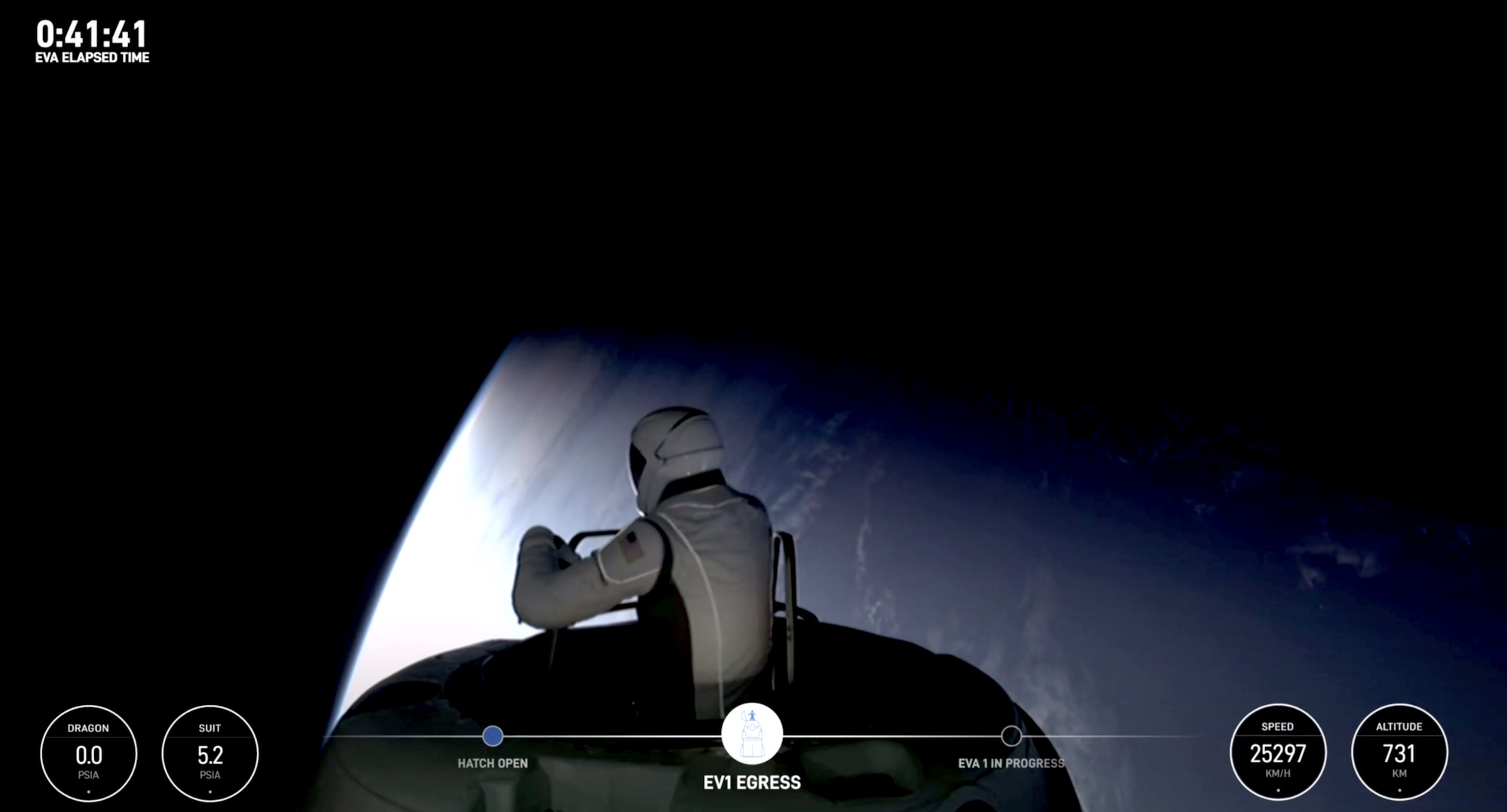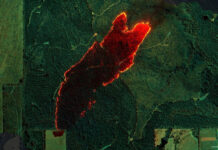Historic Spacewalk by Polaris Dawn Crew Marks a Milestone in Private Space Missions
WASHINGTON — In a groundbreaking event for private space endeavors, astronauts aboard the Polaris Dawn mission successfully conducted the first spacewalk on a non-governmental mission on September 12. This historic event saw astronauts briefly stepping outside their Crew Dragon spacecraft.
Jared Isaacman, the mission commander for the four-person crew, was the first to emerge from the hatch located at the nose of the capsule at around 6:52 a.m. Eastern Time. Utilizing a set of handholds and rails referred to as a "skywalker" by SpaceX, Isaacman evaluated the mobility of the newly designed extravehicular activity (EVA) suit by SpaceX while standing in the hatch.
"Congratulations to the massive team effort that brought us to this milestone. We know this is just the beginning," Isaacman remarked shortly before re-entering the spacecraft.
Approximately eight minutes later, Isaacman returned to the cabin of the Dragon spacecraft. Following his return, mission specialist Sarah Gillis emerged from the hatch at 7:05 a.m. Eastern Time. Similar to Isaacman, she spent around eight minutes performing suit mobility tests within the hatch.
Both astronauts reported that the suits functioned well, displaying good mobility without any significant issues. As planned, neither astronaut floated freely away from the spacecraft; they maintained a secure hold on the skywalker while standing in the hatch.
This spacewalk was the highlight of the five-day Polaris Dawn mission, which launched two days prior. The primary objective was to test the new spacesuits. Additionally, the EVA necessitated modifications to the Crew Dragon itself, enabling the cabin to be depressurized and subsequently repressurized.
Isaacman exited the hatch around 40 minutes after SpaceX officially commenced the spacewalk, which was timed based on the activation of the suits by all four crew members. The other two crew members, pilot Kidd Poteet and mission specialist Anna Menon, also wore EVA suits due to the cabin’s depressurization but remained inside the cabin. After Gillis returned inside, she closed the hatch, and the cabin was repressurized.
Preparation for the spacewalk commenced shortly after the Crew Dragon reached orbit. The cabin pressures were gradually reduced while the oxygen concentrations were increased to help the crew acclimate to the lower pressures inside the suits.
In the 48 hours between the launch of Polaris Dawn and the spacewalk, the Crew Dragon spacecraft achieved a remarkable feat by setting an altitude milestone. Approximately 15 hours after launch, the spacecraft maneuvered to raise its apogee to around 1,400 kilometers. This altitude is the highest for a crewed spacecraft in Earth orbit and the highest altitude reached by a crewed mission since Apollo 17’s lunar mission in 1972.
The Crew Dragon maintained this higher apogee for six orbits before lowering it to around 700 kilometers to facilitate the spacewalk. Throughout the mission, the crew has been conducting various research activities, which will continue for the remainder of the five-day mission.
Understanding the Significance of the Spacewalk
This spacewalk is a monumental achievement for commercial space missions. Historically, spacewalks have been the domain of government space agencies like NASA, Roscosmos, and ESA. The successful execution of an EVA by a private mission demonstrates the growing capabilities and maturity of commercial spaceflight.
The Role of the EVA Suit
The extravehicular activity suit, or EVA suit, is a complex piece of technology designed to protect astronauts from the harsh environment of space. It provides life support, including oxygen and temperature regulation, and shields the wearer from micrometeoroids and radiation. Testing the mobility and functionality of these suits is crucial as it ensures astronaut safety during future spacewalks.
The Spacecraft Modifications
To facilitate the EVA, the Crew Dragon required modifications. One significant change was the ability to depressurize and repressurize the cabin. Depressurizing the cabin involves reducing the air pressure to match the vacuum of space, allowing astronauts to open the hatch without experiencing a dangerous pressure differential. Repressurizing restores the cabin to a breathable atmosphere after the spacewalk.
Altitude Milestone
Reaching an altitude of 1,400 kilometers is a noteworthy achievement. This altitude is significant because it is higher than the typical orbit of the International Space Station (ISS), which orbits at approximately 400 kilometers. Higher altitudes present different challenges, such as increased radiation exposure and orbital mechanics complexities. Achieving this milestone demonstrates the capabilities of the Crew Dragon spacecraft and SpaceX’s expertise in orbital maneuvering.
Research and Experiments
Throughout the mission, the crew has been engaging in various research activities. These experiments range from medical studies to materials science, aiming to advance our understanding of how space conditions affect different biological and physical processes. For instance, studying how human physiology adapts to microgravity can provide insights into long-duration space missions, such as those to Mars.
The Future of Private Space Missions
The success of the Polaris Dawn mission and its EVA sets a precedent for future private space missions. It showcases the evolving role of commercial entities in space exploration, paving the way for more ambitious projects. This mission is part of a broader trend where private companies are taking on roles traditionally held by government space agencies, from launching satellites to crewed missions.
Good to Know: The Polaris Program
The Polaris Dawn mission is part of the Polaris Program, a series of missions aimed at advancing human space exploration. Jared Isaacman, the commander of this mission, is a notable figure in the commercial spaceflight sector. His involvement underscores the collaboration between private funding and technological innovation, driving forward the capabilities of human space exploration.
Reviews and Reactions
The space community has reacted positively to the achievements of the Polaris Dawn mission. Experts have lauded the mission for its successful EVA and altitude milestone, highlighting the significance of these accomplishments in the context of private space exploration. The mission demonstrates the potential of commercial spaceflight to contribute significantly to our understanding of space and our ability to operate in it.
For more detailed information on the Polaris Dawn mission, you can refer to the original article.
In conclusion, the Polaris Dawn mission’s successful spacewalk and altitude milestone represent significant strides in the realm of private space exploration. These achievements highlight the growing capabilities of commercial space missions and set the stage for more ambitious projects in the future. As private companies continue to push the boundaries of space exploration, the collaboration between government agencies and private entities will be crucial in advancing our presence in space.
For more Information, Refer to this article.


































